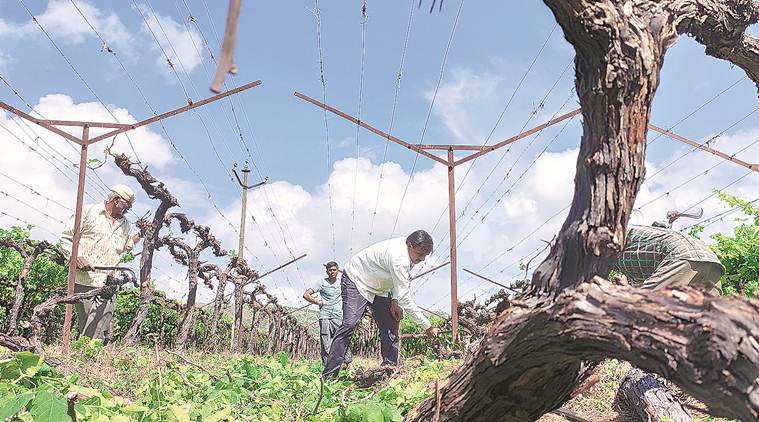- India
- International
Climate change: A story gone sour
Maharashtra’s grape growers are confronting a new problem of unseasonal heavy rain that has caused heavy crop losses.
 A grape vineyard damaged by heavy rains in Dindori taluka of Nashik. (Express photo)
A grape vineyard damaged by heavy rains in Dindori taluka of Nashik. (Express photo)
This is the third time in five years that the grapes in Sanjay Pathade’s 16-acre land have turned black and rotted away at a nascent growth stage. The 48-year-old from Jambutke village in Nashik district’s Dindori taluka had undertaken a second round pruning of his vineyards in mid-September in preparation for a good harvest by late-January. But it started raining heavily from the third week of October. While the rains did stop after the first week of November, their sheer impact, however, created cracks in the 8-10 mm long tender berries and soon reduced the bunches to black desiccated skeletons sans any moisture or developing fruit mass.
“I won’t get a single kg from 15 out of my 16 acres,” sighs this farmer, who will still have to keep spraying Mancozeb 75% wettable powder, copper hydroxide and other fungicides. It has to be done simply to keep the vines free from any downy mildew, powdery mildew, leaf blight and other fungal attacks.
Pathade reckons that since April — when the grape cycle starts with the first pruning of the trees after harvest of fruits from the previous crop — he has spent over Rs 1.5 lakh per acre on fungicides, pesticides, fertilisers and micronutrients. “I would need to spend Rs 10,000-15,000 more till April, before the next crop cycle. It’s like maintaining a cow yielding no milk,” he remarks.
In the first pruning, to make the vineyards ready for bunch bearing, everything is axed, barring the main stem and roots. The second round of pruning around September — to prevent excessive foliage growth that leads to poor air circulation and fungal diseases — sets the stage for flowering, fruit development and final harvesting towards end-January. All through, the vines have to be administered crop protection chemicals based on a rigorous application schedule.
 Ganesh Kadam spraying fungicides in his farm at Mohadi in Nashik. (Express photo)
Ganesh Kadam spraying fungicides in his farm at Mohadi in Nashik. (Express photo)
As Pathade moves around the deceptively lush green canopy devoid of any real fruit bunches — similar to a well-fed but barren cow — he recalls how his crop suffered full-scale damage from heavy rains-induced berry cracking even in October 2017. In September 2015, too, there was similar fruit loss in 12 acres from a powdery mildew infestation and late rains. “In the last five years, I have made money only in 2016 and 2018. In the preceding five years, there were intermittent attacks from insect pests such as thrips and mealybugs, but complete crop loss from unseasonal rains is an altogether new phenomenon,” he says.

An estimated 50,000 hectares, out of Maharashtra’s total 1.40 lakh hectares area under grape cultivation, have reported over 50% crop loss from the latest unseasonal rains. Nashik district — which, along with Sangli and Latur, accounts for the bulk of the state’s grape acreage — had received just 78% of its normal rainfall quota from June till mid-September. But that deficit has since transformed into a cumulative 11.6% surplus till November 13. 50% crop loss on 50,000 hectares, taking an average 25 tonnes per hectare yield and Rs 40,000-50,000 per tonne realisation, translates into Rs 2,500-3,125 crore.
For growers like Pathare, the continuous cycle of losses from climate change has made them think twice about a crop that, for the last many years, has been their source of prosperity. Nashik’s sandy loam soil and warm dry tropical weather has been considered ideal for grape cultivation, while earning it the moniker “California of India”. Water availability from 27 big and small dams, helping to ease moisture stress for the crop during the long dry summer, and good road connectivity, making it easy to transport the harvested produce to domestic markets as well as ports in Mumbai and Gujarat, have given a further boost to the fruit crop in the district.
Nashik’s farmers spend Rs 1.5-2 lakh per acre for growing grapes destined for exports, with the production cost at Rs 80,000-100,000 in the case of locally sold fruit. “Out of my 10 tonnes yield per acre, roughly 8 tonnes make it to the export market. Last season, my average realisation from exportable grapes was Rs 60,000 per tonne and Rs 30,000 for that sold domestically,” confides Pathade, whose net earning per acre worked out to nearly Rs 4 lakh.
Growers plan their field activity with an eye to market their produce either in end-November or end-January. For November harvesting, the second pruning, after which the berries start forming in bunches, is done by end-July. A good harvest requires uninterrupted sunshine and relatively cold nights with little or no rains, especially post the second pruning.
“People think we make lot of money, but they don’t understand this is happening now only once in three years or so. Who will compensate us for this year’s losses or that in 2017 and 2015?”, asks Ganesh Kadam, a farmer from Dindori taluka’s Mohadi village, whose six out of 12 acres under grapes have been entirely destroyed by the recent heavy rains. Last year, out of his 100 tonnes produce, 80 tonnes were for exports.
During 2018-19 (April-March), India exported 2.46 lakh tonnes of fresh grapes valued at $ 334.79 million (Rs 2,335.25 crore). Most of this was to the Netherlands, Russia, United Kingdom, Germany, United Arab Emirates and Saudi Arabia, while being sourced largely from the Nashik belt.
Kadam, like Pathade, is willing to invest both money and time in cultivating exportable grapes. Last year, they got a good return on their investment, thanks to the dry spell post September that enabled a bumper harvest, both in quantity and quality terms. But unseasonal rains are something for which they have no answer.
Vilas Shinde, chairman of the Nashik-headquartered Sahyadri Farmers Producer Company, believes that the root of the problem lies with the Thompson Seedless grapes. This variety from California, introduced four decades ago in Nashik and grown by over 90% of Indian farmers, isn’t designed to withstand heavy rainfall. Shinde points to other Californian varieties like Arra 15, which can tolerate even 120 mm of rain in a single day. He also draws a parallel here with the crisis faced by Italian and South African grape growers in the 1990s.
“Back then, the farmers, exporters, research institutions and governments came together to find a solution. Newer heavy rain-resistant varieties were introduced, giving their industry a new lease of life,” explains Shinde, whose organisation is the country’s biggest grape exporter. Bringing in new grape varieties would mean paying royalty to their breeders, “but our farmers will not mind that,” he adds.
Samir Pandit, director of Rta Technologies Pvt Ltd, a Nashik-based developer of a mobile application Grape Mundo that allows farmers to manage their input applications for growing export-worthy grapes, advocates changing the timing of pruning. “Some of our farmer pruned their crop this time in late-October, instead of September. It prevented any damage to the berries, which were yet to form. Farmers need to adapt, keeping in mind changing rainfall patterns,” he feels.
“By the time the research organisations and agricultural universities have come out with solutions, we would have uprooted our vineyards,” notes Kadam.
Apr 26: Latest News
- 01
- 02
- 03
- 04
- 05








































